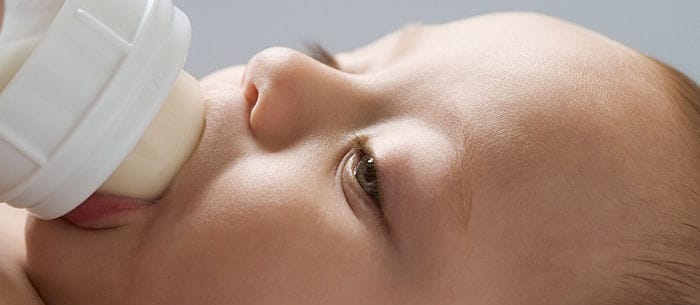You’ve chosen to bottle-feed your baby. So how do you know which baby bottle nipples are the right type to use?
“It’s always a good idea to try a few different nipples and see what your baby prefers, but this can be cost-prohibitive,” says Suzanne Barston, the author of “Bottled Up” and creator of Fearless Formula Feeder.
“I usually suggest buying a few different bottles rather than a big set of one brand, because what if your baby has trouble with that particular brand?” If you’re primarily breastfeeding but offering a bottle from time to time, a wider baby bottle nipple that reflects the natural shape of the breast is a good place to start, Barston also suggests. “If the baby is used to or switching back and forth from breast to bottle, you want to look for a nipple which most closely resembles your own,” she adds. “Sounds weird, but it helps!”
Find the Right Shape
If you are opting to breastfeed as well as bottle-feed right from birth, look for a baby bottle nipple that is shaped like a natural nipple to allow your baby to suck properly from the breast. “Occasionally, after milk supply is established in the first four to six weeks, parents may opt to express mother’s milk and bottle-feed.
In this case, it is personal preference of what parents want to buy, what baby likes,” explains Nancy Dellamaria, an International Board Certified Lactation Consultant (IBCLC). There are also baby bottle nipples on the market called orthodontic nipples, as well. These have a flat side to them that rests on the baby’s tongue to accommodate the baby’s palette more naturally.
“More important than nipple type or brand is the way a parent bottle-feeds a baby,” Dellamaria adds, noting babies should never be ‘propped’ up with bottles in their mouths. “An infant being given breast milk or formula from a bottle should be held in Mom’s or other caregiver’s arms and given little bits of milk at a time, not allowing them to guzzle.”
Start With a Small Size
When you start feeding your newborn, you will likely want to start with the smallest size of baby bottle nipple available for the bottle of your choice. As your baby gets older, you can move through the stages of nipples from size 2 and beyond. While the different sizes of the nipples are generally marked with an age range, don’t be too concerned if your baby prefers a larger or smaller size nipple. Respond to the cues and stick with the one that your baby shows a preference for.
Go With the Flow
Generally, the smallest baby bottle nipples have the slowest flow. As the nipple gets larger, the flow increases. That being said, there are also variable flow nipples on the market. With this type, the flow changes depending on how you hold the bottle. Always watch to make sure that your baby isn’t struggling with the flow from the nipple, and always discuss any feeding concerns with your doctor.
The bottle and baby bottle nipples you start with when you have a newborn may change as your baby gets older. “You always want to choose the slowest flow possible for newborns,” says Barston, which means a size 0 or 1, depending on the brand. As the baby gets older, you can go up in flow, although you don’t need to, she notes. “If your baby is comfortable and eating well with a 1, for example, there’s no need to ever go up to a 2,” she explains.
“But if he is getting frustrated, pulling away and screaming, then the flow may be too slow. If the milk is dripping out of the mouth or he sounds like he is gagging or choking, the flow is too fast.”
Also consider whether your baby experiences any gas, reflux or colic-like symptoms — there are bottles and nipples available to help ease tummy troubles in newborns. These bottles often have an integrated ventilation system and a slower flowing nipple. If there is a concern with gas or reflux, talk to your doctor for a specific bottle recommendation.
Shannon Moyer-Szemenyei is a certified birth and postpartum doula, mother of two busy boys (Owen, 4, and Graeme, 9 months) and the writer at Sweet Stella’s.






